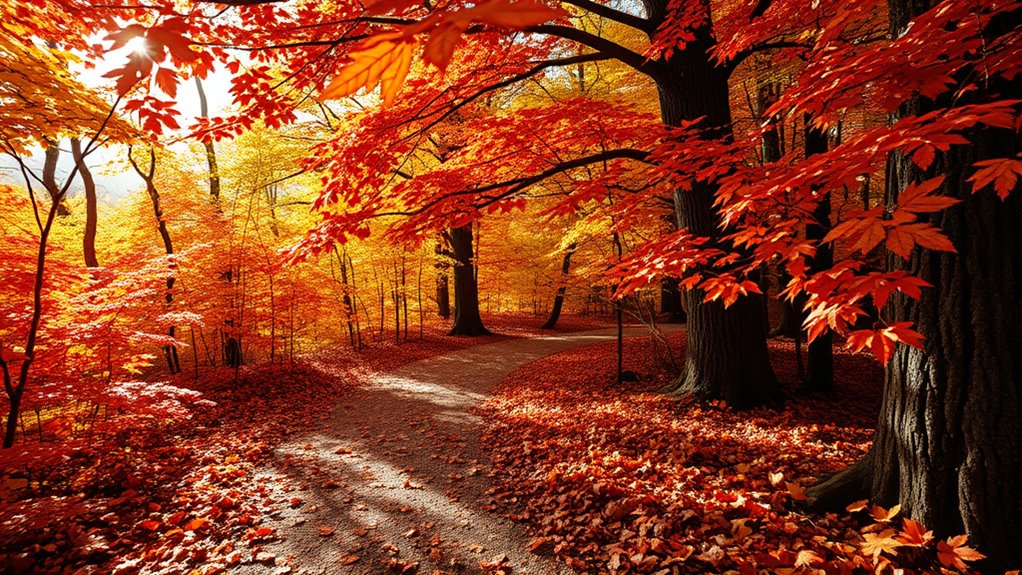To capture stunning fall foliage with your smartphone, aim for the golden hour for soft, warm light that enhances colors. Use grid overlays to keep your horizon straight and experiment with angles — low perspectives highlight leaves, while higher shots showcase landscapes. Focus carefully on details and adjust exposure to balance brightness and prevent glare. Bounce light with a reflector or white paper to brighten shadows. Keep exploring for more tips to elevate your fall photography skills.
Key Takeaways
- Shoot during golden hour or overcast days to achieve soft, vibrant lighting that enhances fall colors.
- Use grid overlays and the rule of thirds to compose balanced, visually appealing shots.
- Focus on specific leaves or branches to capture intricate textures and details sharply.
- Bounce light with reflectors or white paper to brighten darker foliage and highlight warm tones.
- Experiment with different angles, including low perspectives, to add depth and variety to your fall scenes.

Capturing stunning photos with your smartphone is easier than you might think if you know a few key tips. When it comes to fall foliage, the right lighting and composition can make your images truly stand out. Lighting techniques are essential because the natural light during autumn often creates warm, rich tones that can transform a simple shot into something spectacular. Aim to shoot during the golden hour—shortly after sunrise or before sunset—when the sunlight is soft and diffused. This light minimizes harsh shadows and enhances the warm hues of the leaves. If you’re shooting when the sun is higher, try to find shaded areas or use window light if indoors to avoid overexposure and harsh contrasts. Reflectors or even a piece of white paper can help bounce light onto darker areas, highlighting the vibrant colors without losing detail.
Next, focus on composition strategies to elevate your fall foliage photos. Think about framing your shot to include interesting foregrounds or backgrounds that add depth and context. Leading lines, such as paths, fences, or rivers, guide the viewer’s eye toward the colorful trees. Incorporate elements like a person, a park bench, or a rustic bridge to add a sense of scale and storytelling. Pay attention to the rule of thirds—placing key elements along the gridlines or at their intersections creates a balanced, engaging image. Don’t be afraid to experiment with different angles; shooting from a low perspective can make the leaves appear more prominent, while a high vantage point might showcase a sweeping landscape of autumn colors. Look for patterns, contrasts, and symmetry to add visual interest and variety to your shots.
Additionally, utilize your smartphone’s grid overlay to help with composition strategies and guarantee your horizon lines are straight. Tap to focus on specific leaves or branches to sharpen details and bring out the textures and intricate patterns of the foliage. Adjust your exposure manually if your phone allows—sometimes, fall scenes can have a wide range of brightness levels, and tweaking this guarantees the vibrant reds, oranges, and yellows don’t get washed out or overly dark. Moreover, understanding light quality can significantly influence the mood and vibrancy of your photos. Finally, keep an eye on the weather forecast; shooting on days with clear skies or gentle overcast spreads the light evenly and enhances the natural colors without glare or unwanted shadows. With attention to lighting techniques and thoughtful composition strategies, you’ll be capturing breathtaking fall foliage photos that showcase the season’s vibrant beauty.
Frequently Asked Questions
Which Smartphone Camera Settings Work Best for Fall Foliage?
To best capture fall foliage, use your smartphone’s manual focus to guarantee sharp images of leaves and trees. Enable HDR mode to balance the bright sky and vibrant colors, making the foliage pop without overexposure. Adjust exposure settings if possible, and shoot during the golden hours for softer light. These settings help you highlight the rich hues and details, creating stunning fall scenes with your smartphone.
How to Avoid Glare When Photographing Leaves?
To avoid glare when photographing leaves, use a polarized filter on your smartphone or shoot at a different angle. This filter cuts down on reflections and enhances color vibrancy. Additionally, take advantage of natural lighting, ideally during the golden hours of early morning or late afternoon, when sunlight is softer. By combining these techniques, you’ll capture clearer, more vivid images of fall foliage without unwanted glare.
What Are the Best Times of Day for Vibrant Fall Colors?
You’ll get the best fall colors during peak lighting, typically in the mid-morning or late afternoon when the sunlight is softer and warmer. Clear weather conditions enhance the vibrancy of the leaves, making them pop in your photos. Avoid midday when the sun is harsh and can wash out colors. By shooting during these times, you’ll capture stunning, vibrant fall foliage that truly stands out.
How Can I Enhance Colors in Post-Processing?
Imagine capturing a stunning fall scene where colors look muted. You can enhance colors in post-processing by increasing color saturation using editing software. For example, boosting saturation makes those vibrant reds and oranges pop, bringing your photo to life. Be careful not to overdo it, keeping the image natural. Adjustments like this help you emphasize fall’s beauty, making your smartphone photos truly stand out.
Should I Use a Tripod for Capturing Fall Scenes?
Using a tripod for capturing fall scenes is a smart choice to guarantee tripod stability, especially in low light or when taking long exposures. It helps you avoid camera shake and keeps your shot sharp, highlighting vibrant foliage. However, if you’re aiming for handheld flexibility to quickly capture fleeting moments, skip the tripod. Balance your need for stability with the spontaneity of fall scenery to get the best shot.
Conclusion
As you embrace these smartphone photography tips, remember that sometimes the most beautiful moments are found in the subtle shifts and fleeting colors. By capturing fall’s gentle progression, you learn to see beyond the obvious and appreciate the quiet magic around you. Keep your lens steady and your heart open, for the true art lies in recognizing the beauty that’s quietly unfolding—reminding us that life’s most vibrant details often go unnoticed if we’re not paying close attention.









